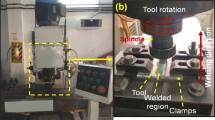Abstract
In this article, friction stir welded T-joints of innovative dissimilar aluminum alloys have been produced and tested with the aim to investigate the feasibility of using this joining technique, in this configuration, in the aerospace field with the final aim to save weight. The introduction of both this new welding technique and innovative alloys, such as AA 2198 and AA 6056, could allow making lighter and stronger structures. Some experiments, carried out previously, have shown that the fixturing device, the tool geometry, and the tilt angle play a significant role in the joint soundness. A wide experimental characterization has been carried out on FSW T-joints of AA 6056 T4 extrudes to AA 2198 T3 rolled plates. The results attained allow to put in evidence some critical issues on the investigated configuration and can be considered as a further acquired knowledge in the understanding and the design of friction stir processes.















Similar content being viewed by others

References
R.S. Mishra and Z.Y. Ma, Friction Stir Welding and Processing, Mater. Sci. Eng. R, 2005, 50, p 1–78
L. Dubourg, A. Merati, and M. Jahazi, Process Optimisation and Mechanical Properties of Friction Stir Lap Welds of 7075-T6 Stringers on 2024-T3 Skin, Mater. Des., 2010, 31, p 3324–3330
L. Fratini, G. Buffa, L. Filice, and F. Gagliardi, FSW of AA6082–T6 T-Joints: Process Engineering and Performance Measurement, J. Eng. Manuf. Pt B, 2006, 220(5), p 669–676
L. Fratini, F. Micari, A. Squillace, and G. Giorleo, Experimental Characterization of FSW T-Joints of Light Alloys, Key Eng. Mater., 2007, 344, p 751–758
M. Guerra, C. Schmidt, L.C. McClure, L.E. Murr, and A.C. Nunes, Flow Patterns During Friction Stir Welding, Mater. Charact., 2003, 49, p 95–101
C.G. Rhodes, M.W. Mahoney, W.H. Bingel, R.A. Spurling, and C.C. Bampton, Effects of Friction Stir Welding on Microstructure of 7075 Aluminum, Scripta Mater., 1997, 36(1), p 69–75
J.Q. Su, T.W. Nelson, R. Mishra, and M. Mahoney, Microstructural Investigation of Friction Stir Welded 7050-T654 Aluminium, Acta Mater., 2003, 51, p 713–729
M. Peel, A. Steuwer, M. Preuss, and J.P. Withers, Microstructure, Mechanical Properties and Residual Stresses as a Function of Welding Speed in Aluminium AA5083 Friction Stir Welds, Acta Mater., 2003, 51(16), p 4791–4801
L. Fratini, G. Buffa, and R. Shivpuri, Influence of Material Characteristics on Plastomechanics of the FSW Process for T-Joints, Mater. Des., 2009, 30(7), p 2435–2445
C. Padovani, L. Fratini, A. Squillace, and F. Bellucci, Electrochemical Analysis on Friction Stir Welded and Laser Welded 6XXX Aluminium Alloys T-Joints, Corros Rev, 2007, 25(3–4), p 475–489
R.S. James, Aluminium-Lithium Alloys, Metals Handbook, Vol 2, 10th ed., ASM International, Materials Park, OH, 1990, p 178–199
ASTM E3 Standard Guide for Preparation of Metallographic Specimens
ASTM E 340 Test Method for Macroetching Metals and Alloys
ASTM E 1558 Guide to Electrolytic Polishing of Metallographic Specimens
ASTM G 44 Standard Practice for exposure of Metals and Alloys by Alternate Immersion in Neutral 3.5% Sodium Chloride Solution
ASTM G 47 Standard Test Method for Determining Susceptibility to Stress Corrosion Cracking of 2xxx and 7xxx Aluminium Alloys Products
ASTM G 49 Standard Practice for Preparation and Use of Direct Tension Stress Corrosion Test Specimens
A. Prisco, F. Acerra, F. Bellucci, A. Squillace, C. Pirozzi, U. Prisco, and G. Giorleo, LBW of Similar and Dissimilar Skin-Stringer Joints. Part I: Process optimization and Mechanical Characterization. Adv. Mater. Res., 2008, 38, p 306–319. ISSN: 1022-6680: Trans Tech Publications (Switzerland)
P.R. Roberge, Handbook of Corrosion Engineering, McGraw-Hill, New York, 2000
ASTM G5 Standard Reference Test Method for Making Potentiostatic and Potentiodynamic Anodic Polarization Measurements
Acknowledgment
Authors acknowledge Alenia Aeronautica S.p.A for providing materials to make joints and supporting research activity.
Author information
Authors and Affiliations
Corresponding author
Rights and permissions
About this article
Cite this article
Astarita, A., Squillace, A., Scala, A. et al. On the Critical Technological Issues of Friction Stir Welding T-Joints of Dissimilar Aluminum Alloys. J. of Materi Eng and Perform 21, 1763–1771 (2012). https://doi.org/10.1007/s11665-011-0073-3
Received:
Revised:
Published:
Issue Date:
DOI: https://doi.org/10.1007/s11665-011-0073-3



